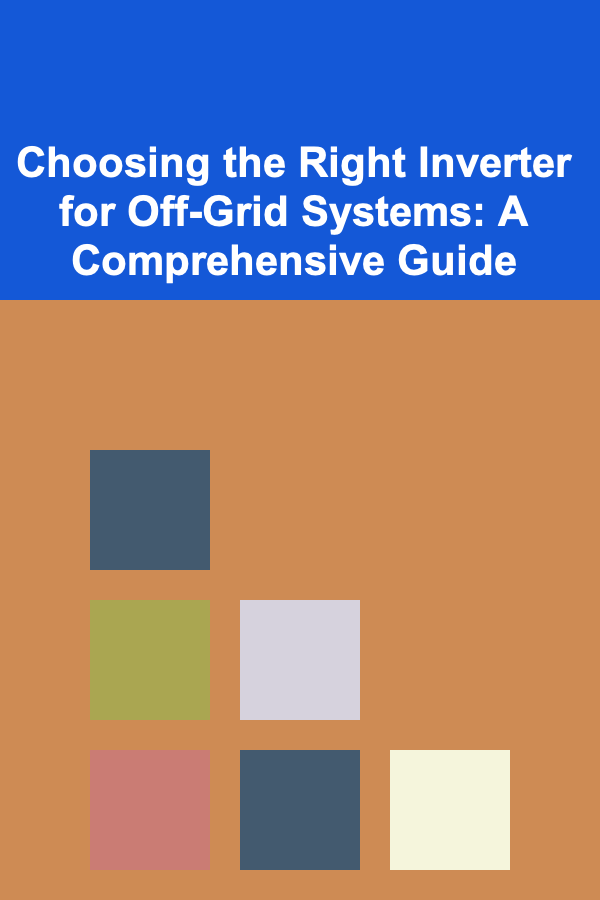
Choosing the Right Inverter for Off-Grid Systems: A Comprehensive Guide
ebook include PDF & Audio bundle (Micro Guide)
$12.99$8.99
Limited Time Offer! Order within the next:

Off-grid living represents a significant step towards energy independence, offering freedom from the constraints and costs associated with traditional utility grids. At the heart of any successful off-grid system lies the inverter, a crucial component responsible for converting the direct current (DC) electricity generated by solar panels, wind turbines, or other renewable sources into alternating current (AC) electricity suitable for powering household appliances, tools, and other electrical devices. Selecting the correct inverter is paramount for system performance, reliability, and longevity. This comprehensive guide explores the key considerations and factors involved in choosing the right inverter for your specific off-grid needs.
Understanding the Role of an Inverter in Off-Grid Systems
Before diving into the selection criteria, it's essential to understand the fundamental role of an inverter within an off-grid system. Inverters are not merely DC-to-AC converters; they are sophisticated power management devices. They perform several critical functions:
- DC-to-AC Conversion: This is the primary function. The inverter efficiently transforms the DC voltage from your battery bank (fed by renewable energy sources) into a stable and usable AC voltage, typically 120V or 240V, depending on your region's electrical standards.
- Voltage Regulation: Inverters maintain a consistent AC voltage output, even when the DC input voltage from the battery fluctuates. This is critical for protecting sensitive electronic equipment.
- Frequency Regulation: Similar to voltage regulation, inverters ensure a stable AC frequency (typically 60Hz in North America and 50Hz in Europe) to synchronize with appliances and prevent damage.
- Overload Protection: Inverters are designed to handle temporary power surges, such as those that occur when starting motors or appliances. They usually have built-in overload protection mechanisms that will shut down the inverter if it exceeds its capacity, preventing damage.
- Battery Management (in some models): Some advanced inverters incorporate battery charging and management capabilities. These inverters can automatically regulate the charging process, optimizing battery lifespan and performance. They may also offer features like low-voltage disconnect to prevent excessive battery discharge.
Key Factors to Consider When Choosing an Off-Grid Inverter
Selecting the appropriate inverter requires careful consideration of several critical factors:
1. Power Requirements (Wattage)
Determining the total power consumption of your off-grid system is the most crucial step. You need to calculate the total wattage of all the appliances and devices you intend to run simultaneously. This calculation should include both continuous and surge power requirements.
- Continuous Power: This is the power your devices consume while running normally. You can usually find this information on the appliance's nameplate or in its user manual, expressed in watts (W). For example, a refrigerator might consume 150W continuously.
- Surge Power: Many appliances, particularly those with electric motors (refrigerators, freezers, pumps, power tools), require a significantly higher surge of power to start up. This "surge" or "peak" power can be several times higher than the continuous running power. Again, consult the appliance's documentation to determine its surge wattage. If the surge wattage isn't explicitly stated, a general rule of thumb is to multiply the continuous wattage by 2-3 for devices with basic motors and by 3-5 for devices with more complex motors, like those found in air conditioners.
Calculating Total Power Requirements:
- List all the appliances you intend to use simultaneously.
- Note the continuous wattage for each appliance.
- Note the surge wattage for each appliance.
- Calculate the total continuous wattage by summing the continuous wattage of all appliances.
- Identify the appliance with the highest surge wattage. Add this surge wattage to the total continuous wattage. This result is your required inverter surge capacity.
- Compare the surge wattage requirement with the sum of the continuous wattage. The higher of the two will determine the size of the inverter you need.
Example:
Let's say you want to run the following appliances simultaneously:
- Refrigerator: Continuous 150W, Surge 600W
- Lights: Continuous 100W, Surge 100W
- Laptop: Continuous 50W, Surge 50W
- Water Pump: Continuous 300W, Surge 900W
Total Continuous Wattage: 150W + 100W + 50W + 300W = 600W
Highest Surge Wattage: Water Pump (900W)
Required Inverter Size: 600W (Continuous) + 900W (Surge) = 1500W
Therefore, you would need an inverter with a continuous power rating of at least 600W and a surge capacity of at least 1500W. It's always prudent to choose an inverter with a slightly higher capacity than your calculated requirements (e.g., a 2000W inverter in this case) to provide a safety margin and accommodate future expansion.
2. Inverter Type: Modified Sine Wave vs. Pure Sine Wave
Inverters come in two primary types, distinguished by the waveform of the AC electricity they produce:
- Modified Sine Wave Inverters: These inverters produce a stepped waveform that approximates a sine wave. They are generally less expensive than pure sine wave inverters. However, they are less efficient and may not be compatible with all electronic devices. Some sensitive electronics, such as audio equipment, laser printers, and some newer appliances with electronic controls, may not function correctly or may be damaged by a modified sine wave inverter. Motors may also run hotter and less efficiently.
- Pure Sine Wave Inverters: These inverters produce a smooth, sinusoidal waveform that is virtually identical to the electricity supplied by a utility grid. They are more expensive than modified sine wave inverters, but they provide cleaner, more reliable power and are compatible with virtually all electronic devices. Pure sine wave inverters are the preferred choice for most off-grid applications, especially if you plan to run sensitive electronics or appliances with motors.
Recommendation: While modified sine wave inverters may seem appealing due to their lower cost, the potential compatibility issues and inefficiencies make pure sine wave inverters the better long-term investment for most off-grid systems. The reliability and compatibility offered by pure sine wave inverters outweigh the initial cost difference.
3. Voltage Compatibility
Ensure that the inverter's DC input voltage matches the voltage of your battery bank. Common battery bank voltages include 12V, 24V, and 48V. Using an inverter with an incorrect voltage can damage the inverter and/or the battery bank. Higher voltage battery banks (e.g., 48V) are generally more efficient for larger systems, as they reduce the amount of current flowing through the wires, minimizing energy losses due to resistance. Carefully match the inverter's DC input voltage specification to your battery bank voltage. Some inverters can operate with different voltage configurations, but you'll need to ensure you configure it correctly for the specific voltage you are using.
4. Efficiency
Inverter efficiency is the ratio of AC output power to DC input power, expressed as a percentage. A higher efficiency rating indicates that the inverter wastes less energy during the conversion process, resulting in more usable AC power and longer battery runtimes. Inverter efficiency typically ranges from 85% to 95%. Even small improvements in efficiency can translate into significant energy savings over the long term. Look for inverters with high efficiency ratings, especially at lower power levels, as inverters often operate at partial load. Consider the "no-load" or "standby" power consumption as well. This is the power the inverter consumes when it's turned on but not supplying any load. Lower no-load power consumption reduces unnecessary battery drain.
5. Features and Functionality
Inverters can offer a variety of features and functionalities that enhance their performance and usability:
- Battery Charger: Some inverters include a built-in battery charger, allowing you to charge your battery bank from an AC source, such as a generator or the utility grid (if available). This can be a valuable backup option for periods of low solar or wind energy production.
- Transfer Switch: A transfer switch automatically switches the AC power source between the inverter and another AC source, such as a generator or the grid. This ensures a seamless transition in case of inverter failure or battery depletion.
- Remote Monitoring and Control: Some inverters offer remote monitoring and control capabilities, allowing you to monitor system performance, adjust settings, and receive alerts remotely via a smartphone app or web interface. This can be particularly useful for off-grid systems located in remote areas.
- Stacking Capability: Some inverters can be "stacked" or connected in parallel to increase the total output power. This allows you to expand your system's capacity as your energy needs grow.
- Low-Voltage Disconnect: This feature prevents excessive battery discharge by automatically shutting down the inverter when the battery voltage drops below a certain threshold. This helps protect the battery from damage and prolong its lifespan.
- Automatic Generator Start (AGS): This feature automatically starts a generator when the battery voltage drops below a predefined level or when the inverter is overloaded. This provides an automatic backup power source to ensure continuous operation.
6. Safety Features
Safety is paramount when dealing with electrical systems. Choose an inverter with robust safety features to protect yourself, your equipment, and your property:
- Overload Protection: As mentioned earlier, this protects the inverter from damage caused by excessive power draw.
- Short Circuit Protection: This protects the inverter from damage caused by short circuits in the AC wiring.
- Over-Temperature Protection: This protects the inverter from overheating by shutting it down when the internal temperature exceeds a safe limit.
- Reverse Polarity Protection: This protects the inverter from damage if the battery is connected with the wrong polarity.
- Ground Fault Protection: This protects against electrical shock hazards by detecting and interrupting ground faults.
Look for inverters that are certified by recognized safety organizations, such as UL (Underwriters Laboratories) or CE (Conformité Européenne).
7. Environmental Considerations
The environment in which the inverter will operate can significantly impact its performance and lifespan. Consider the following factors:
- Temperature: Inverters are sensitive to temperature extremes. Operating an inverter outside its specified temperature range can reduce its efficiency, performance, and lifespan. Choose an inverter that is designed to operate in the expected temperature range of your location. Ensure adequate ventilation to prevent overheating.
- Humidity: High humidity can corrode electronic components and lead to malfunctions. Choose an inverter that is designed to withstand humid environments or install it in a dry, well-ventilated location.
- Altitude: Altitude can affect the inverter's cooling capacity. If you live at a high altitude, choose an inverter that is designed for high-altitude operation.
- Dust and Dirt: Dust and dirt can accumulate inside the inverter and impede its cooling ability. Choose an inverter with a sealed enclosure or install it in a clean environment. Regular cleaning is also recommended.
8. Brand Reputation and Warranty
Choose an inverter from a reputable manufacturer with a proven track record of producing reliable and high-quality products. Research different brands and read online reviews to get a sense of their reputation. A longer warranty period is a good indication of the manufacturer's confidence in their product. Also, consider the availability of technical support and spare parts. A manufacturer with a strong customer support network can provide valuable assistance in case of problems or questions.
Inverter Sizing Examples for Different Off-Grid Scenarios
To illustrate the principles discussed above, here are a few examples of inverter sizing for different off-grid scenarios:
Scenario 1: Small Cabin with Minimal Power Needs
- Appliances: Lights (100W), Laptop (50W), Cellphone Charger (10W)
- Total Continuous Wattage: 160W
- Highest Surge Wattage: Laptop (50W, assume no surge above continuous)
- Required Inverter Size: At least 200W continuous. A small, 300-500W pure sine wave inverter would be suitable.
Scenario 2: Medium-Sized Home with Essential Appliances
- Appliances: Refrigerator (150W continuous, 600W surge), Lights (200W), TV (100W), Water Pump (300W continuous, 900W surge)
- Total Continuous Wattage: 750W
- Highest Surge Wattage: Water Pump (900W)
- Required Inverter Size: 750W + 900W = 1650W. A 2000W-3000W pure sine wave inverter would be recommended to provide sufficient headroom for surges and future expansion.
Scenario 3: Large Home with Multiple High-Power Appliances
- Appliances: Refrigerator (150W continuous, 600W surge), Lights (300W), TV (150W), Water Pump (500W continuous, 1500W surge), Washing Machine (400W continuous, 1200W surge), Air Conditioner (1000W continuous, 3000W surge)
- Total Continuous Wattage: 2500W
- Highest Surge Wattage: Air Conditioner (3000W)
- Required Inverter Size: 2500W + 3000W = 5500W. A larger inverter, such as a 6000W or 8000W pure sine wave inverter, or multiple stacked inverters, would be necessary to handle the high continuous and surge power demands. In this scenario, a 48V battery bank is highly recommended for improved efficiency.
Installation and Maintenance
Proper installation and maintenance are crucial for ensuring the longevity and reliability of your inverter.
- Installation: Follow the manufacturer's instructions carefully when installing the inverter. Ensure that the inverter is properly grounded and connected to the battery bank with appropriately sized cables. Place the inverter in a well-ventilated location, away from direct sunlight and moisture.
- Maintenance: Regularly inspect the inverter for signs of damage or wear. Clean the inverter regularly to remove dust and dirt. Check the battery connections to ensure they are tight and corrosion-free. If you notice any unusual noises or smells coming from the inverter, contact a qualified technician for assistance.
Conclusion
Choosing the right inverter is a critical decision for any off-grid system. By carefully considering the factors outlined in this guide, including power requirements, inverter type, voltage compatibility, efficiency, features, safety, environmental considerations, and brand reputation, you can select an inverter that meets your specific needs and ensures the reliable and efficient operation of your off-grid power system. Remember to always prioritize safety and consult with qualified professionals when designing and installing your off-grid system. Investing in a high-quality inverter will pay off in the long run with improved performance, increased reliability, and a more sustainable and independent lifestyle.

How to Approach Environmentalism in Different Cultures
Read More
How to Extend the Life of Your Home Appliances with Proper Care
Read More
How to Use a Whiteboard for Effective Project Management
Read More
How to Use Props and Demonstrations Effectively
Read More
How To Find Free Entertainment and Activities
Read More
Understanding the Role of Community in Gaming
Read MoreOther Products

How to Approach Environmentalism in Different Cultures
Read More
How to Extend the Life of Your Home Appliances with Proper Care
Read More
How to Use a Whiteboard for Effective Project Management
Read More
How to Use Props and Demonstrations Effectively
Read More
How To Find Free Entertainment and Activities
Read More